Search Thermo Fisher Scientific
Page Contents
Qdot nanocrystal probes represent a truly enabling nanotechnology, offering revolutionary fluorescence performance that includes:
- Long-term photostability for live-cell imaging and dynamics studies
- Brilliant colors for simple, single-excitation multicolor analysis
- Narrow, symmetrical emission spectra for low interchannel crosstalk
- Fixability for follow-up immunofluorescence after in vivo studies
Multicolor, multiplex assays are a particularly important application of Qdot nanocrystal conjugates. The emission from Qdot nanocrystals is narrow and symmetrical; therefore, overlap with other emission colors is minimal, producing less bleed through into adjacent detection channels and allowing many more colors to be used simultaneously. Because each type of Qdot nanocrystal is based on the same underlying material (they differ primarily in core size, as described below), the conjugation and assay methods for one color are easily extrapolated to other colors, simplifying protocol development. Furthermore, every Qdot nanocrystal can be excited using a single light source (e.g., 405 nm violet diode laser), reducing the need for multiple lasers or laborious alignments and compensations when performing three- or four-color detection assays.
Fundamentally, Qdot nanocrystals are fluorophores—substances that absorb photons of light, then re-emit photons at a different wavelength. However, they exhibit some important differences when compared with traditional fluorophores such as organic fluorescent dyes and naturally fluorescent proteins. Qdot probes combine the revolutionary fluorescence performance inherent in the nanocrystal structure with a highly customizable surface for directing their bioactivity, producing a fluorescent probe that outperforms traditional dyes in many fluorescence applications.
Structural Properties
Qdot nanocrystals are nanometer-scale atom clusters comprising a core, shell and surface coating (Figure 6.6.1). The core is made up of a few hundred to a few thousand atoms of a semiconductor material (cadmium selenide (CdSe) or cadmium telluride (CdTe)). A semiconductor shell (typically zinc sulfide (ZnS)) surrounds and stabilizes the core, improving both the optical and physical properties of the material.
The core–shell assembly as initially prepared is extremely hydrophobic. An amphiphilic polymer coating is then applied, serving two purposes. Firstly, it incorporates ionizable functional groups that confer water solubility essential for bioanalytical applications. Secondly, it provides a platform for covalent functionalization of the Qdot nanocrystal with antibodies, streptavidin, oligonucleotides and other affinity reagents (denoted as "biomolecule" in Figure 6.6.1) that confer targeting specificity for biomolecular detection. As depicted in Figure 6.6.1, Qdot nanocrystal conjugates typically incorporate multiple copies of the affinity reagent—the inverse of the situation encountered in dye-labeled conjugates in which multiple dyes are attached to a single affinity reagent.
In most of our Qdot nanocrystal conjugates, the affinity reagent is coupled to the amphiphilic polymer coating via a functionalized polyethylene glycol (PEG) linker. PEG linkers have been shown to reduce nonspecific binding in flow cytometry ![]() and imaging assays,
and imaging assays,![]() thereby improving signal-to-noise ratios. Qdot primary and secondary antibody conjugates, Qdot streptavidin conjugates, Qtracker non-targeted quantum dots, and Qdot ITK amino (PEG) quantum dots, as well as the reactive nanocrystals provided in the Qdot Antibody Conjugation Kits, all utilize this PEG linker chemistry.
thereby improving signal-to-noise ratios. Qdot primary and secondary antibody conjugates, Qdot streptavidin conjugates, Qtracker non-targeted quantum dots, and Qdot ITK amino (PEG) quantum dots, as well as the reactive nanocrystals provided in the Qdot Antibody Conjugation Kits, all utilize this PEG linker chemistry.
The overall size of functionalized Qdot nanocrystals, in a spherical approximation, is around 20 nm in diameter (Figure 6.6.2). This is much larger than an organic dye and comparable to the size of a large (molecular weight >500 kDa) protein or our smallest FluoSpheres fluorescent microspheres (Microspheres—Section 6.5). The novel physical properties of Qdot nanocrystals coupled to the fact that they contain cadmium ![]() gives rise to concerns regarding toxicity in applications involving live cells or in vivo administration. These concerns have prompted much investigation.
gives rise to concerns regarding toxicity in applications involving live cells or in vivo administration. These concerns have prompted much investigation.![]() It is difficult to draw general conclusions from these studies due to the influence of the cellular, tissue or animal context on the results. Toxicity concerns, however, are generally mitigated by the extraordinarily high fluorescence output of Qdot nanocrystals, which enables the use of very low (often nanomolar) working concentrations. The extent to which the size of Qdot nanocrystals may cause perturbations of molecular interactions has also been subjected to detailed scrutiny.
It is difficult to draw general conclusions from these studies due to the influence of the cellular, tissue or animal context on the results. Toxicity concerns, however, are generally mitigated by the extraordinarily high fluorescence output of Qdot nanocrystals, which enables the use of very low (often nanomolar) working concentrations. The extent to which the size of Qdot nanocrystals may cause perturbations of molecular interactions has also been subjected to detailed scrutiny.![]()
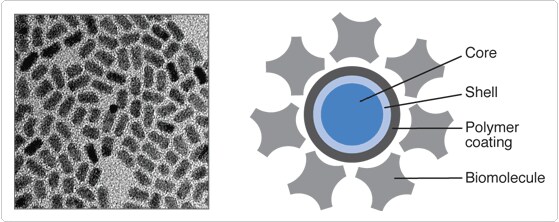
Figure 6.6.1 Structure of a Qdot nanocrystal. A) Qdot nanocrystals containing core and shell components only are shown in this transmission electron microscope image (200,000× magnification). B) In this schematic of the overall structure of a Qdot nanocrystal conjugate, the layers represent the distinct structural elements and are roughly to scale.
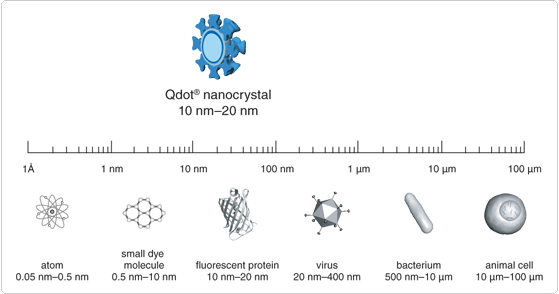
Figure 6.6.2 Relative size of Qdot nanocrystals.
Spectroscopic Properties
Although Qdot nanocrystals are composed of semiconductor materials, their small size results in spectroscopic properties that are radically different from those of bulk semiconductors. Absorption of a photon causes an electron to move from the semiconductor valence band to the conductance band, creating an exciton (electron-hole pair). Absorption occurs as long as the energy of the incident photons is higher than the semiconductor bandgap energy; thus, excitons can be created over a wide range of energies within the nanocrystal core. The higher-energy excitons relax to the lowest bandgap energy before they recombine and emit a photon. Therefore, the wavelength range of the absorption spectrum is broad, whereas that of the emission spectrum is narrow (Figure 6.6.3, Figure 6.6.4, Figure 6.6.5).
Due to the small size of the nanocrystal, the electron-hole separation is confined to be smaller than the Bohr radius of the semiconductor. As the nanocrystal core is made progressively smaller, more energy is required to confine the exciton, and the energy of the emitted photons increases. Therefore, smaller nanocrystals exhibit shorter-wavelength emission. By controlled variation of the core size, we have developed a range of nanocrystals with distinctively different emission spectral characteristics (Figure 6.6.5) but largely overlapping absorption spectra (Figure 6.6.4) and generally similar physical properties. Currently, we offer eight Qdot nanocrystal types identified by 3-digit numerals representing the peak emission wavelength in nanometers (e.g., Qdot 655 nanocrystal, emission peak = 655 nm).
The spectral characteristics of Qdot nanocrystals offer some distinctive advantages over those of organic dyes and fluorescent proteins,![]() particularly with regard to implementation of spectral multiplex detection schemes. The broad absorption spectra facilitate single-source (e.g., 405 nm) excitation of multiple Qdot nanocrystal types. Furthermore, Qdot nanocrystals lack the ubiquitous red-edge "tail" of organic dye and fluorescent protein emission spectra (Figure 6.6.3), reducing the likelihood of detection channel crosstalk. Qdot nanocrystals have been extensively characterized and utilized as donors in fluorescence resonance energy transfer (FRET) assays (Fluorescence Resonance Energy Transfer (FRET)—Note 1.2) of molecular proximity.
particularly with regard to implementation of spectral multiplex detection schemes. The broad absorption spectra facilitate single-source (e.g., 405 nm) excitation of multiple Qdot nanocrystal types. Furthermore, Qdot nanocrystals lack the ubiquitous red-edge "tail" of organic dye and fluorescent protein emission spectra (Figure 6.6.3), reducing the likelihood of detection channel crosstalk. Qdot nanocrystals have been extensively characterized and utilized as donors in fluorescence resonance energy transfer (FRET) assays (Fluorescence Resonance Energy Transfer (FRET)—Note 1.2) of molecular proximity.![]() Their utility as FRET acceptors is limited by their absorption spectral characteristics (Figure 6.6.4), making it difficult to avoid direct, proximity-independent fluorescence excitation. However, they work well as acceptors from lanthanide chelate donors in time-resolved FRET (TR-FRET) assays, in which fluorescence originating from direct excitation is eliminated by time-gating of the detection system.
Their utility as FRET acceptors is limited by their absorption spectral characteristics (Figure 6.6.4), making it difficult to avoid direct, proximity-independent fluorescence excitation. However, they work well as acceptors from lanthanide chelate donors in time-resolved FRET (TR-FRET) assays, in which fluorescence originating from direct excitation is eliminated by time-gating of the detection system.![]()
Another distinctive property of Qdot nanocrystals relative to organic dyes and fluorescent proteins is their prodigious fluorescence output, which principally derives from their extraordinarily large extinction coefficients for absorption (Extinction coefficients of Qdot nanocrystal streptavidin conjugates at ultraviolet and visible wavelengths—Table 6.10, Figure 6.6.3). Organic dye and fluorescent protein extinction coefficients do not often exceed 105 cm-1M-1, whereas those of Qdot nanocrystals are often >106 cm-1M-1, particularly in the blue visible and ultraviolet wavelength regions (Figure 6.6.3, Figure 6.6.4). Because their fluorescence quantum yields are high and comparable to those of organic dyes and fluorescent proteins,![]() the large capacity for photon absorption represented by the extinction coefficient is propagated into emission of fluorescence photons. The fluorescence lifetimes of Qdot nanocrystals are typically in the 10–30 nanosecond range as compared to 1–10 nanoseconds for most organic dyes.
the large capacity for photon absorption represented by the extinction coefficient is propagated into emission of fluorescence photons. The fluorescence lifetimes of Qdot nanocrystals are typically in the 10–30 nanosecond range as compared to 1–10 nanoseconds for most organic dyes.![]() They also have very large two-photon absorption cross-sections,
They also have very large two-photon absorption cross-sections,![]() resulting in exceptional performance in two-photon excitation microscopy applications
resulting in exceptional performance in two-photon excitation microscopy applications ![]() (Fluorescent Probes for Two-Photon Microscopy—Note 1.5). Qdot nanocrystals are much less susceptible to photobleaching than organic dyes and fluorescent proteins.
(Fluorescent Probes for Two-Photon Microscopy—Note 1.5). Qdot nanocrystals are much less susceptible to photobleaching than organic dyes and fluorescent proteins.![]() This feature is particularly beneficial in protocols involving repeated image captures on a single field of view such as confocal z-stack
This feature is particularly beneficial in protocols involving repeated image captures on a single field of view such as confocal z-stack ![]() or longitudinal time-lapse acquisitions.
or longitudinal time-lapse acquisitions.
Furthermore, Qdot nanocrystals exhibit fluorescence intermittency, commonly referred to as blinking, whereby continuously excited single fluorophores will spontaneously alternate between emitting and non-emitting states across timescales from milliseconds to many seconds.![]() By its nature, blinking does not significantly impact ensemble measurements. Instead, it is most readily observable in single molecule detection trajectories where the binary nature of the "on" and "off" emission levels provides a useful confirmatory indication that the signals represent single fluorophores rather than clustered multiples.
By its nature, blinking does not significantly impact ensemble measurements. Instead, it is most readily observable in single molecule detection trajectories where the binary nature of the "on" and "off" emission levels provides a useful confirmatory indication that the signals represent single fluorophores rather than clustered multiples.
Qdot nanocrystals are intrinsically electron dense due to the tightly packed atomic lattice of the core–shell assembly, making them directly detectable by electron microscopy (EM).![]() They can therefore be used as dual-mode contrast agents for correlated fluorescence and EM without the diaminobenzidine photoconversion and subsequent osmification processing steps required for EM level visualization of organic dyes
They can therefore be used as dual-mode contrast agents for correlated fluorescence and EM without the diaminobenzidine photoconversion and subsequent osmification processing steps required for EM level visualization of organic dyes ![]() (Fluorescent Probes for Photoconversion of Diaminobenzidine Reagents—Note 14.2). Furthermore, particle size and shape differences can be used as identifying characteristics in EM in the same way that emission spectra are used in fluorescence microscopy.
(Fluorescent Probes for Photoconversion of Diaminobenzidine Reagents—Note 14.2). Furthermore, particle size and shape differences can be used as identifying characteristics in EM in the same way that emission spectra are used in fluorescence microscopy.![]()
Since the first reported applications of quantum dot nanocrystals for biomolecular detection in 1998,![]() many reviews have been published that may be consulted for further information on their properties and applications, both actual and prospective.
many reviews have been published that may be consulted for further information on their properties and applications, both actual and prospective.![]()
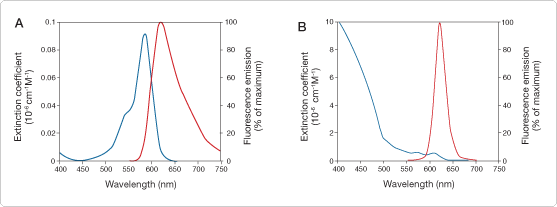
Figure 6.6.3 Absorption and fluorescence emission spectra of A) an organic dye (Alexa Fluor 594 dye) and B) a quantum dot nanocrystal (Qdot 625 nanocrystal). Absorption spectra are plotted in terms of molar extinction coefficient to illustrate the 100-fold larger values of this parameter typically exhibited by quantum dot nanocrystals relative to organic dyes. Comparison of the emission spectra illustrates the narrower bandwidths typical of quantum dot nanocrystals. In particular, Alexa Fluor 594 dye exhibits significant emission intensity at wavelengths >700 nm whereas Qdot 625 nanocrystal exhibits essentially none (note that the emission peak positions of the two fluorophores are almost identical). Overlay comparisons of Qdot nanocrystal spectra with those of organic dyes and fluorescent proteins can be generated using our online Fluorescence SpectraViewer utility.
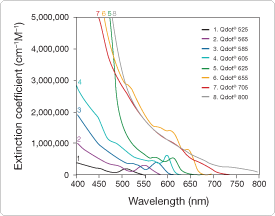
Figure 6.6.4 Absorption spectra of Qdot nanocrystals plotted in terms of molar extinction coefficient.
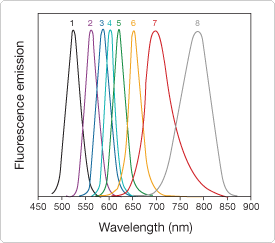
Figure 6.6.5 Normalized fluorescence emission spectra of Qdot nanocrystals: 1) Qdot 525, 2) Qdot 565, 3) Qdot 585, 4) Qdot 605, 5) Qdot 625, 6) Qdot 655, 7) Qdot 705, 8) Qdot 800 nanocrystals.
Qdot Streptavidin Conjugates
Streptavidin conjugates provide access to a wide range of biomolecular functionality via high-affinity avidin–biotin coupling (Biotin and Hapten Derivatives—Chapter 4), making them perhaps the most versatile subset in our range of Qdot nanocrystal labeling reagents:
- Qdot 525 streptavidin conjugate (Q10141MP)
- Qdot 565 streptavidin conjugate (Q10131MP)
- Qdot 585 streptavidin conjugate (Q10111MP)
- Qdot 605 streptavidin conjugate (Q10101MP)
- Qdot 625 streptavidin conjugate (Q22063, A10196)
- Qdot 655 streptavidin conjugate (Q10121MP)
- Qdot 705 streptavidin conjugate (Q10161MP)
- Qdot 800 streptavidin conjugate (Q10171MP)
For example, nucleic acid hybridization can be detected by complexation of terminally biotinylated oligonucleotides with Qdot streptavidin conjugates ![]() (Figure 6.6.6). Qdot streptavidin conjugates in combination with biotinylated antibodies provide increased multiplexing capacity for immunodetection of proteins on both imaging
(Figure 6.6.6). Qdot streptavidin conjugates in combination with biotinylated antibodies provide increased multiplexing capacity for immunodetection of proteins on both imaging ![]() and flow cytometry
and flow cytometry ![]() platforms. Single-particle tracking of molecular motion is a particularly compelling application of Qdot streptavidin conjugates that takes advantage of their extraordinary fluorescence output capacity.
platforms. Single-particle tracking of molecular motion is a particularly compelling application of Qdot streptavidin conjugates that takes advantage of their extraordinary fluorescence output capacity.![]() The principal subjects for these measurements are cell-surface receptors
The principal subjects for these measurements are cell-surface receptors ![]() and molecular motors such as myosin.
and molecular motors such as myosin.![]() Single-molecule detection uncovers details of molecular motion and assembly that are obscured by the averaging effects of bulk measurements. Qdot nanocrystals are quite essential in such applications as fluorescence photon output ultimately propagates into the spatial and temporal resolution of the measurements.
Single-molecule detection uncovers details of molecular motion and assembly that are obscured by the averaging effects of bulk measurements. Qdot nanocrystals are quite essential in such applications as fluorescence photon output ultimately propagates into the spatial and temporal resolution of the measurements.
Typically, labeling is accomplished using biotinylated ligands such as biotin EGF (E3477, Biotin and Desthiobiotin Conjugates—Section 4.3) and biotin-XX α-bungartoxin (B1196, Biotin and Desthiobiotin Conjugates—Section 4.3) to couple Qdot streptavidin conjugates to the receptor of interest. Because these conjugates incorporate multiple streptavidins (typically 5–10 per Qdot nanocrystal), careful attention must be paid to the streptavidin:ligand stoichiometry to avoid receptor crosslinking mediated by the Qdot streptavidin–biotinyated ligand complex.![]() A molar excess of Qdot streptavidin conjugate over the biotinylated ligand biases the complex stoichiometry towards the desired outcome of one ligand per nanocrystal. Qdot streptavidin conjugates are supplied as 1 µM solutions in 50 mM borate, pH 8.3 containing 0.05% sodium azide and 1 M betaine cryoprotectant in 200 µL units. The Qdot Streptavidin Sampler Kit (Q10151MP) provides 50 µL units of six different Qdot streptavidin conjugates in a single package.
A molar excess of Qdot streptavidin conjugate over the biotinylated ligand biases the complex stoichiometry towards the desired outcome of one ligand per nanocrystal. Qdot streptavidin conjugates are supplied as 1 µM solutions in 50 mM borate, pH 8.3 containing 0.05% sodium azide and 1 M betaine cryoprotectant in 200 µL units. The Qdot Streptavidin Sampler Kit (Q10151MP) provides 50 µL units of six different Qdot streptavidin conjugates in a single package.
We also offer Qdot ITK streptavidin quantum dots, in which streptavidin is directly attached to the inner amphiphilic coating without a PEG linker:
- Qdot Streptavidin Sampler Kit *1 µM solutions* (Q10151MP)
- Qdot 525 ITK Streptavidin Conjugate Kit (Q10041MP)
- Qdot 565 ITK Streptavidin Conjugate Kit (Q10031MP)
- Qdot 585 ITK Streptavidin Conjugate Kit (Q10011MP)
- Qdot 605 ITK Streptavidin Conjugate Kit (Q10001MP)
- Qdot 655 ITK Streptavidin Conjugate Kit (Q10021MP)
- Qdot 705 ITK Streptavidin Conjugate Kit (Q10061MP)
- Qdot 800 ITK Streptavidin Conjugate Kit (Q10071MP)
This formulation results in a smaller overall particle size and an increase in the number of streptavidins per nanocrystal relative to PEG-linked conjugates. These characteristics are advantageous in fluorescence resonance energy transfer (FRET) assays for detecting hybridization of target nucleic acid sequences to biotinylated oligonucleotides captured on the Qdot nanocrystal surface.![]() Qdot ITK streptavidin conjugates are supplied in 250 µL units of 2 µM solution in kits that also provide Qdot incubation buffer (50 mM borate buffer, pH 8.3, containing 2% BSA and 0.05% sodium azide). Qdot incubation buffer is also available in separately packaged 30 mL units (Q20001MP).
Qdot ITK streptavidin conjugates are supplied in 250 µL units of 2 µM solution in kits that also provide Qdot incubation buffer (50 mM borate buffer, pH 8.3, containing 2% BSA and 0.05% sodium azide). Qdot incubation buffer is also available in separately packaged 30 mL units (Q20001MP).
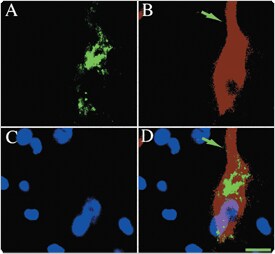
Figure 6.6.6 Multiplex mRNA in situ hybridization and immunofluorescence localization of tyrosine hydroxylase in mouse brain using Qdot 525 and Qdot 605 streptavidin conjugates (Q10141MP, Q10101MP). A) Vmat2 mRNA–positive neurons in substantia nigra were probed with a biotinylated oligonucleotide and labeled with Qdot 525 streptavidin conjugate. B) The same cell was labeled with anti–tyrosine hydroxylase (TH) antibody in conjunction with biotinylated secondary antibody and Qdot 605 streptavidin conjugate. The Vmat2 mRNA signal is restricted to the cytoplasm, whereas the labeling of TH is extended to the whole cell body and processes (arrow). C) Cell nuclei were labeled with DAPI. D) Overlay of all three stained images shows the different subcellular distributions of Vmat2 mRNA and TH immunoreactivity. Scale bar = 15 μm. Images contributed by Stuart Sealfon, Mount Sinai School of Medicine, and reprinted with permission from Nucleic Acids Res (2005) 33:e161.![]()
Biotinylated Qdot Nanocrystals
The Qdot 605 and Qdot 655 Biotin Conjugate Kits (Q10301MP, Q10321MP) provide Qdot nanocrystals that have been functionalized with biotin on their surface via carbodiimide-mediated coupling. The resulting conjugates typically incorporate 5–7 biotin groups per Qdot nanocrystal. In addition to biotinylated Qdot nanocrystals, these kits also provide Qdot incubation buffer, which is formulated specifically to achieve improved signal-to-noise ratios in immunohistochemical applications. Biotinylated Qdot nanocrystals have been used alongside biotinylated microspheres (see above) for analysis of the effects of fluorescent label size on ligand–receptor binding dynamics and equilibria by fluorescence correlation spectroscopy ![]() (Fluorescence Correlation Spectroscopy (FCS)—Note 1.3).
(Fluorescence Correlation Spectroscopy (FCS)—Note 1.3).
WesternDot Western Blot Kits
The WesternDot 625 Goat Anti-Mouse and Goat Anti-Rabbit Western Blot Kits (W10132, W10142) provide Qdot nanocrystal secondary reagents for the detection of subnanogram amounts of protein on western blots without the complications of time-dependent signal development imposed by enzyme-amplified chemiluminescence detection systems. These kits provide Qdot 625 streptavidin conjugates and biotinylated secondary antibodies for use in combination with user-supplied mouse or rabbit primary antibodies against the protein of interest. In other respects, immunodetection of proteins immobilized on nitrocellulose (NC) or polyvinylidene difluoride (PVDF) membranes follows standard western blotting protocols. Detection of the fluorescence signal can be accomplished using standard UV- or blue light–based gel and blot imaging systems and does not require specialized emission filters.
WesternDot Secondary Antibody Conjugates
With recent advances in Qdot probe technology and fluorescence imaging platforms, researchers are now able to obtain detection sensitivities from fluorescence-based detection comparable with those obtained from ECL (Figure 6.6.7). Furthermore, unlike ECL techniques, fluorescence-based detection methods provide the capability to detect multiple antigens on a single blot without stripping and reprobing. Importantly, probes with long-wavelength (red to near-IR) emission allow signal collection beyond the typical autofluorescence emitted by standard nitrocellulose and PVDF membranes, resulting in low background fluorescence and superior signal-to-noise ratios.
WesternDot secondary antibody conjugates provide a powerful alternative to traditional methods for western blot detection. The WesternDot secondary antibody conjugates allow detection of proteins that have been immobilized on membranes (nitrocellulose or PVDF) following western transfer. These conjugates utilize Qdot nanocrystals enhanced with VIVID technology, making them brighter than the original Qdot antibody conjugates. The unique fluorescent properties of WesternDot antibody conjugates allow simultaneous detection of multiple proteins on a single blot without stripping and reprobing or producing duplicate gels and blots. The stability of the WesternDot reagents makes it possible to take multiple images and store dried blots for months with minimal loss of fluorescent signal. Protein bands can be captured with fluorescent imagers equipped with UV, violet or deep-blue excitation wavelengths, including gel imagers with a UV transilluminator. Our current selection of WesternDot secondary antibody conjugates includes:
- WesternDot 585 donkey anti-mouse, anti-rabbit and anti-goat conjugates (W10800, W10801, W10802)
- WesternDot 585 goat anti-mouse and anti-rabbit conjugates (W10803, W10804)
- WesternDot 625 donkey anti-mouse, anti-rabbit and anti-goat conjugates (W10805, W10806, W10807)
- WesternDot 625 goat anti-mouse and anti-rabbit conjugates (W10808, W10809)
- WesternDot 655 donkey anti-mouse, anti-rabbit and anti-goat conjugates (W10810, W10811, W10812)
- WesternDot 655 goat anti-mouse and anti-rabbit conjugates (W10813, W10814)
- WesternDot 800 goat anti-mouse and anti-rabbit conjugates (W10815, W10816)
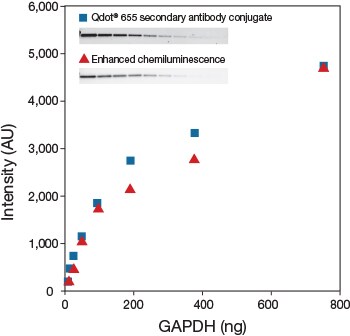
Figure 6.6.7 Comparison of enhanced chemiluminescence (ECL)– and Qdot® fluorescence–based western blot protein detection. Serial dilutions (750–3 ng protein) of GAPDH were run on NuPAGE® Novex® 4–12% Bis-Tris precast gels and transferred to iBlot® nitrocellulose membranes using the iBlot® Gel Transfer Device. The membranes were then probed with mouse anti-GAPDH antibodies followed by either ECL detection using a horseradish peroxidase goat anti–mouse IgG conjugate or fluorescence detection using Qdot 655 goat anti–mouse IgG conjugate. Images were collected using the Fujifilm® LAS-4000 gel imager. Partial blot images show GAPDH detection, and the graph shows the detection sensitivities of the two techniques. AU = arbitrary units.
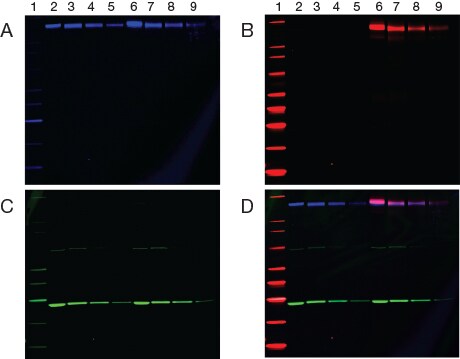
Figure 6.6.8 Simultaneous detection of three proteins on a single blot using Qdot® secondary antibody conjugates. A western blot containing serial dilutions (20–3 µg protein) of lysates from unstimulated (lanes 2–5) and hEGF-stimulated (lanes 6–9) A431 cells was probed with mouse anti-EGFR, rabbit anti–phospho-EGFR, and chicken anti-GAPDH antibodies, followed by A) Qdot® 800 goat anti-mouse (pseudocolored blue), B) Qdot® 605 goat anti-rabbit (pseudocolored red), and C) Qdot® 655 goat anti-chicken (pseudocolored green) conjugates. D) The merged image shows overlaid red and blue bands as purple. The blot contains MagicMark™ XP Western Protein Standard (lane 1) and was imaged using the Fujifilm® LAS-4000 gel imager.
Qdot Secondary Antibody Conjugates
Qdot secondary antibody conjugates (Qdot nanocrystal secondary antibody conjugates—Table 6.11) combine the spectral characteristics of Qdot nanocrystals with the selective binding of F(ab’)2 fragments from affinity-purified secondary antibodies, enabling a wide range of immunocytochemical and immunohistochemical applications ![]() (Figure 6.6.9, Figure 6.6.10). Some examples include immunolabeling of GABAA receptor α1 and γ2 subunits for colocalization analysis in HEK 293 cells
(Figure 6.6.9, Figure 6.6.10). Some examples include immunolabeling of GABAA receptor α1 and γ2 subunits for colocalization analysis in HEK 293 cells ![]() and immunodetection of EGFR, E-cadherin and cytokeratin on formalin-fixed, paraffin-embedded (FFPE) tissue array slides.
and immunodetection of EGFR, E-cadherin and cytokeratin on formalin-fixed, paraffin-embedded (FFPE) tissue array slides.![]()
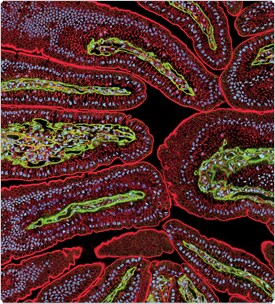
Figure 6.6.9 Multicolor immunofluorescence imaging with Qdot secondary antibody conjugates. Actin in a mouse intestine section was detected with mouse anti-actin antibody and Qdot 655 goat F(ab')2 anti–mouse IgG antibody (red; Q11021MP, Q11022MP), laminin was detected with rabbit anti-laminin antibody and Qdot 525 goat F(ab')2 anti–rabbit IgG antibody (green, Q11441MP), and nuclei were stained with Hoechst 33342 (blue). Image contributed by Thomas Deerinck and Mark Ellisman, The National Center for Microscopy and Imaging Research, San Diego, California, USA.
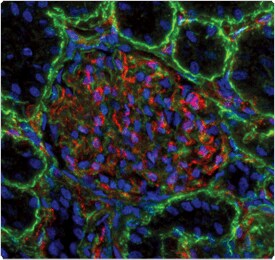
Figure 6.6.10 Multicolor immunofluorescence imaging with Qdot secondary antibody conjugates. Laminin in a mouse kidney section was labeled with a rabbit anti-laminin primary antibody and visualized using green-fluorescent Qdot 565 F(ab')2 anti–rabbit IgG secondary antibody (Q11431MP, Q114432MP). PECAM-1 (platelet/endothelial cell adhesion molecule-1, CD31) was labeled with a rat anti–PECAM-1 primary antibody and visualized using red-fluorescent Qdot 655 F(ab')2 anti–rat IgG secondary antibody (Q11621MP). Nuclei were counterstained with blue-fluorescent Hoechst 33342. Image contributed by Stuart Shand, Center for Biologic Imaging, University of Pittsburgh.
Qmount Qdot Mounting Media
Qmount Qdot mounting media (Q10336) is a specialized mountant that preserves the fluorescence signal of Qdot nanocrystals with little to no quenching of the initial signal intensity. The formulation cures within 12 hours and is provided in a convenient and easy-to-use dropper bottle. This mounting medium offers excellent compatibility with Qdot secondary antibody and streptavidin conjugates in immunocytochemical and immunohistochemical detection applications, as well with Qnuclear Deep Red stain (Q10363, Probes for the Nucleus—Section 12.5), which is the recommended nuclear counterstain for these applications.
Anti–Human CD Antibodies
Immunophenotyping of leukocytes based on expression of cell-surface CD (cluster of differentiation) markers is a mainstream flow cytometry application in both clinical and research settings.![]() Our Qdot nanocrystal–conjugated mouse monoclonal anti–human CD antibodies (Qdot nanocrystal anti–human CD antibody conjugates—Table 6.12) bring extended multiplexing capacity and unmatched fluorescence output to enhance conventional leukocyte immunophenotyping protocols
Our Qdot nanocrystal–conjugated mouse monoclonal anti–human CD antibodies (Qdot nanocrystal anti–human CD antibody conjugates—Table 6.12) bring extended multiplexing capacity and unmatched fluorescence output to enhance conventional leukocyte immunophenotyping protocols ![]() (Figure 6.6.11). The large selection of Invitrogen anti–human CD antibodies labeled with Alexa Fluor dyes, phycobiliproteins and phycobiliprotein tandem fluorophores
(Figure 6.6.11). The large selection of Invitrogen anti–human CD antibodies labeled with Alexa Fluor dyes, phycobiliproteins and phycobiliprotein tandem fluorophores ![]() can be surveyed using our online primary antibody search utility at www.invitrogen.com/handbook/antibodies.
can be surveyed using our online primary antibody search utility at www.invitrogen.com/handbook/antibodies.
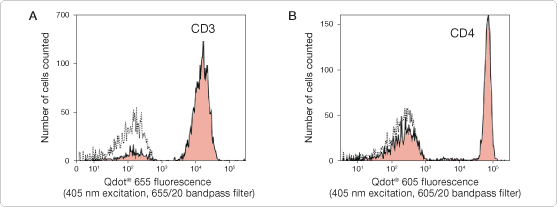
Figure 6.6.11 Antigen detection in human peripheral blood lymphocytes. Cells were incubated with A) Qdot 655 mouse anti–human CD3 antibody (Q10012) or B) Qdot 605 mouse anti–human CD4 antibody (Q10008). Samples were then subjected to flow cytometric analysis using LSR II flow cytometers and FACSDiva software (BD Biosciences) or FlowJo software (Tree Star, Inc.). The gray overlay peaks represent a sample of unstained cells.
Qdot Antibody Conjugation Kits
Qdot Antibody Conjugation Kits provide reagents and protocols for researchers to prepare Qdot nanocrystal conjugates of independently sourced antibodies:
- Qdot 525 Antibody Conjugation Kit (Q22041MP)
- Qdot 565 Antibody Conjugation Kit (Q22031MP)
- Qdot 585 Antibody Conjugation Kit (Q22011MP)
- Qdot 605 Antibody Conjugation Kit (Q22001MP)
- Qdot 625 Antibody Conjugation Kit (A10197)
- Qdot 655 Antibody Conjugation Kit (Q22021MP)
- Qdot 705 Antibody Conjugation Kit (Q22061MP)
- Qdot 800 Antibody Conjugation Kit (Q22071MP)
The conjugation reaction involves reduction of antibody interchain disulfides followed by coupling of the resulting free thiols to amine-derivatized, PEG-coated Qdot nanocrystals via the heterobifunctional crosslinker SMCC (S1534, Chemical Crosslinking Reagents—Section 5.2). Primary antibodies labeled using these methods have demonstrated utility in applications as diverse as multiplexed immunodetection of biomarkers in formalin-fixed, paraffin-embedded (FFPE) tissue sections ![]() and in vivo imaging of HER2-positive tumors in mice.
and in vivo imaging of HER2-positive tumors in mice.![]()
Other Qdot Nanocrystal Conjugates
The Qdot 655 wheat germ agglutinin (WGA) conjugate (Q12021MP) extends our selection of dye-labeled WGA conjugates (Lectins and Other Carbohydrate-Binding Proteins—Section 7.7) for labeling of N-acetylglucosamine and N-acetylneuraminic acid (sialic acid) residues of glycoproteins on cell surfaces.![]() WGA conjugates are also useful for labeling of bacterial cell wall peptidoglycans, chitin and cartilage glycosaminoglycans.
WGA conjugates are also useful for labeling of bacterial cell wall peptidoglycans, chitin and cartilage glycosaminoglycans.
Qtracker Cell Labeling Kits
Qtracker Cell Labeling Kits provide Qdot nanocrystals that have been functionalized on their surface with polyarginine peptides to facilitate spontaneous uptake by live cells:![]()
- Qtracker 525 Cell Labeling Kit (Q25041MP; trial size, Q25049)
- Qtracker 565 Cell Labeling Kit (Q25031MP)
- Qtracker 585 Cell Labeling Kit (Q25011MP)
- Qtracker 605 Cell Labeling Kit (Q25001MP)
- Qtracker 625 Cell Labeling Kit (A10198)
- Qtracker 655 Cell Labeling Kit (Q25021MP; trial size, Q25029)
- Qtracker 705 Cell Labeling Kit (Q25061MP; trial size, Q25069)
- Qtracker 800 Cell Labeling Kit (Q25071MP; trial size, Q25079)
The mechanism whereby such cell-penetrating peptides induce the cellular uptake of cargoes—including oligonucleotides and proteins as well as Qdot nanocrystals—remains a topic of active investigation and considerable debate.![]() However, it is reasonably well established that the uptake is passive and does not require specific receptors or active transport processes. Therefore, labeling of live cells is a simple matter of adding the Qtracker cell labeling reagents supplied in the kits to adherent or suspension cells in complete growth medium, incubating at 37ºC for 45–60 minutes, followed by a wash step to remove the unincorporated labeling reagents. The Qdot nanocrystals are stably incorporated in cytoplasmic vesicles (Figure 6.6.12) and are passed to daughter cells upon cell division but are not transferred to adjacent cells in mixed cultures or host tissues. Fluorescence is not impacted by complex and varying cellular environments such as changes in intracellular pH, temperature and metabolic activity. A wide range of applications for Qtracker Cell Labeling Kits have been reported, including fiducial marking of cell populations for identification during or after downstream analysis,
However, it is reasonably well established that the uptake is passive and does not require specific receptors or active transport processes. Therefore, labeling of live cells is a simple matter of adding the Qtracker cell labeling reagents supplied in the kits to adherent or suspension cells in complete growth medium, incubating at 37ºC for 45–60 minutes, followed by a wash step to remove the unincorporated labeling reagents. The Qdot nanocrystals are stably incorporated in cytoplasmic vesicles (Figure 6.6.12) and are passed to daughter cells upon cell division but are not transferred to adjacent cells in mixed cultures or host tissues. Fluorescence is not impacted by complex and varying cellular environments such as changes in intracellular pH, temperature and metabolic activity. A wide range of applications for Qtracker Cell Labeling Kits have been reported, including fiducial marking of cell populations for identification during or after downstream analysis,![]() labeling of mouse cerebral vascular tissue for visualization of explantation,
labeling of mouse cerebral vascular tissue for visualization of explantation,![]() imaging the assembly of cultured pulmonary artery adventitial fibroblasts and endothelial cells into three-dimensional structures
imaging the assembly of cultured pulmonary artery adventitial fibroblasts and endothelial cells into three-dimensional structures ![]() and tracking embryonic and mesenchymal stem cells.
and tracking embryonic and mesenchymal stem cells.![]()
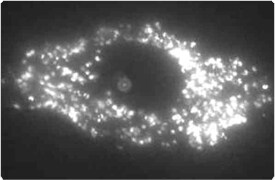
Figure 6.6.12 Distribution of Qdot nanocrystals in cytoplasmic vesicles after labeling cells with the Qtracker 655 Cell Labeling Kit (Q25021MP). HeLa cells were labeled with the Qtracker 655 Cell Labeling Kit and then observed using a Leica TCS SP2 confocal microscope (excitation at 488 nm). This representative image shows the Qdot nanocrystals distributed in vesicles throughout the cytoplasm.
Qtracker Non-Targeted Quantum Dots
Qtracker non-targeted quantum dots are designed for small animal in vivo imaging, and especially for studying vascular structure after microinjection ![]() (Figure 6.6.13). Our selection of Qtracker non-targeted quantum dots includes:
(Figure 6.6.13). Our selection of Qtracker non-targeted quantum dots includes:
- Qtracker 565 non-targeted quantum dots (Q21031MP)
- Qtracker 655 non-targeted quantum dots (Q21021MP)
- Qtracker 705 non-targeted quantum dots (Q21061MP)
- Qtracker 800 non-targeted quantum dots (Q21071MP)
These nanocrystals exhibit intense red or near-infrared fluorescence emission, enabling maximum transmission through tissues while avoiding interference from background autofluorescence. Qtracker non-targeted quantum dots have polyethylene glycol (PEG) surface coatings to minimize nonspecific binding interactions and associated inflammatory responses.![]() Because the PEG surface coating does not contain reactive functional groups, the Qtracker non-targeted quantum dots are retained in circulation longer and can be imaged for up to 3 months without additional injections.
Because the PEG surface coating does not contain reactive functional groups, the Qtracker non-targeted quantum dots are retained in circulation longer and can be imaged for up to 3 months without additional injections.![]() Qtracker non-targeted quantum dots are supplied as 2 µM solutions in 50 mM borate buffer, pH 8.3 in units of 200 µL.
Qtracker non-targeted quantum dots are supplied as 2 µM solutions in 50 mM borate buffer, pH 8.3 in units of 200 µL.
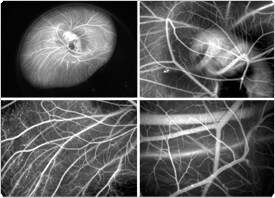
Figure 6.6.13 Chick embryo injected through the major vitelline vein with Qtracker non-targeted quantum dots. Following a few minutes of circulation of the Qtracker 705 non-targeted quantum dots (Q21061MP), fluorescence images of the embryo were captured at increasing magnification using 460 nm excitation and a digital imaging system equipped with appropriate emission filters. These Qtracker reagents revealed highly detailed vascular structure at all levels of magnification. Images contributed by Greg Fisher, Carnegie Mellon University.
Qdot ITK Quantum Dots
ITK (Innovator’s Tool Kit) quantum dots enable researchers to equip Qdot nanocrystals with customized functionalities by means of surface derivatization (Figure 6.6.14). Qdot ITK quantum dots are available with three different surface chemistries—carboxyl groups, amino (PEG) groups and aliphatic hydrocarbon—and up to nine different fluorescent colors (525, 545, 565, 585, 605, 625, 655, 705 or 800 nm emission).
Qdot ITK carboxyl quantum dots have a carboxyl-derivatized amphiphilic coating and can be coupled to amine groups of proteins and modified oligonucleotides in aqueous solution using EDAC-mediated condensation ![]() (Derivatization Reagents for Carboxylic Acids and Carboxamides—Section 3.4). Our Qdot ITK carboxyl quantum dots are provided as 8 µM solutions and include:
(Derivatization Reagents for Carboxylic Acids and Carboxamides—Section 3.4). Our Qdot ITK carboxyl quantum dots are provided as 8 µM solutions and include:
- Qdot 525 ITK carboxyl quantum dots (Q21341MP)
- Qdot 545 ITK carboxyl quantum dots (Q21391MP)
- Qdot 565 ITK carboxyl quantum dots (Q21331MP)
- Qdot 585 ITK carboxyl quantum dots (Q21311MP)
- Qdot 605 ITK carboxyl quantum dots (Q21301MP)
- Qdot 625 ITK carboxyl quantum dots (A10200)
- Qdot 655 ITK carboxyl quantum dots (Q21321MP)
- Qdot 705 ITK carboxyl quantum dots (Q21361MP)
- Qdot 800 ITK carboxyl quantum dots (Q21371MP)
Qdot ITK amino (PEG) quantum dots have amine-derivatized PEG covalently attached to the amphiphilic inner coating and react efficiently with succinimidyl ester derivatives and other amine-reactive compounds.![]() Our Qdot ITK amino (PEG) quantum dots are provided as 8 µM solutions and include:
Our Qdot ITK amino (PEG) quantum dots are provided as 8 µM solutions and include:
- Qdot 525 ITK amino (PEG) quantum dots (Q21541MP)
- Qdot 545 ITK amino (PEG) quantum dots (Q21591MP)
- Qdot 565 ITK amino (PEG) quantum dots (Q21531MP)
- Qdot 585 ITK amino (PEG) quantum dots (Q21511MP)
- Qdot 605 ITK amino (PEG) quantum dots (Q21501MP)
- Qdot 655 ITK amino (PEG) quantum dots (Q21521MP)
- Qdot 705 ITK amino (PEG) quantum dots (Q21561MP)
- Qdot 800 ITK amino (PEG) quantum dots (Q21571MP
Qdot ITK organic quantum dots have an aliphatic hydrocarbon surface coating instead of an amphiphilic polymer coating. They are provided as a suspension in decane and are specifically designed for applications requiring organic solvents. Our Qdot ITK organic quantum dots are provided as 1 µM solutions and include:
- Qdot 545 ITK organic quantum dots (Q21791MP)
- Qdot 565 ITK organic quantum dots (Q21731MP)
- Qdot 585 ITK organic quantum dots (Q21711MP)
- Qdot 605 ITK organic quantum dots (Q21701MP)
- Qdot 655 ITK organic quantum dots (Q21721MP)
- Qdot 705 ITK organic quantum dots (Q21761MP)
- Qdot 800 ITK organic quantum dots (Q21771MP)
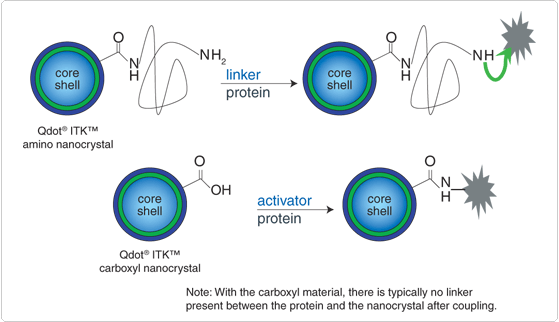
Figure 6.6.14 Coupling of Qdot ITK quantum dots. Qdot ITK amino (PEG) quantum dots can be coupled to biomolecules using amine-reactive crosslinking chemistries. Qdot ITK carboxyl quantum dots can be coupled to amine-containing biomolecules by amide linkages generated by EDAC-mediated condensation.
For Research Use Only. Not for use in diagnostic procedures.